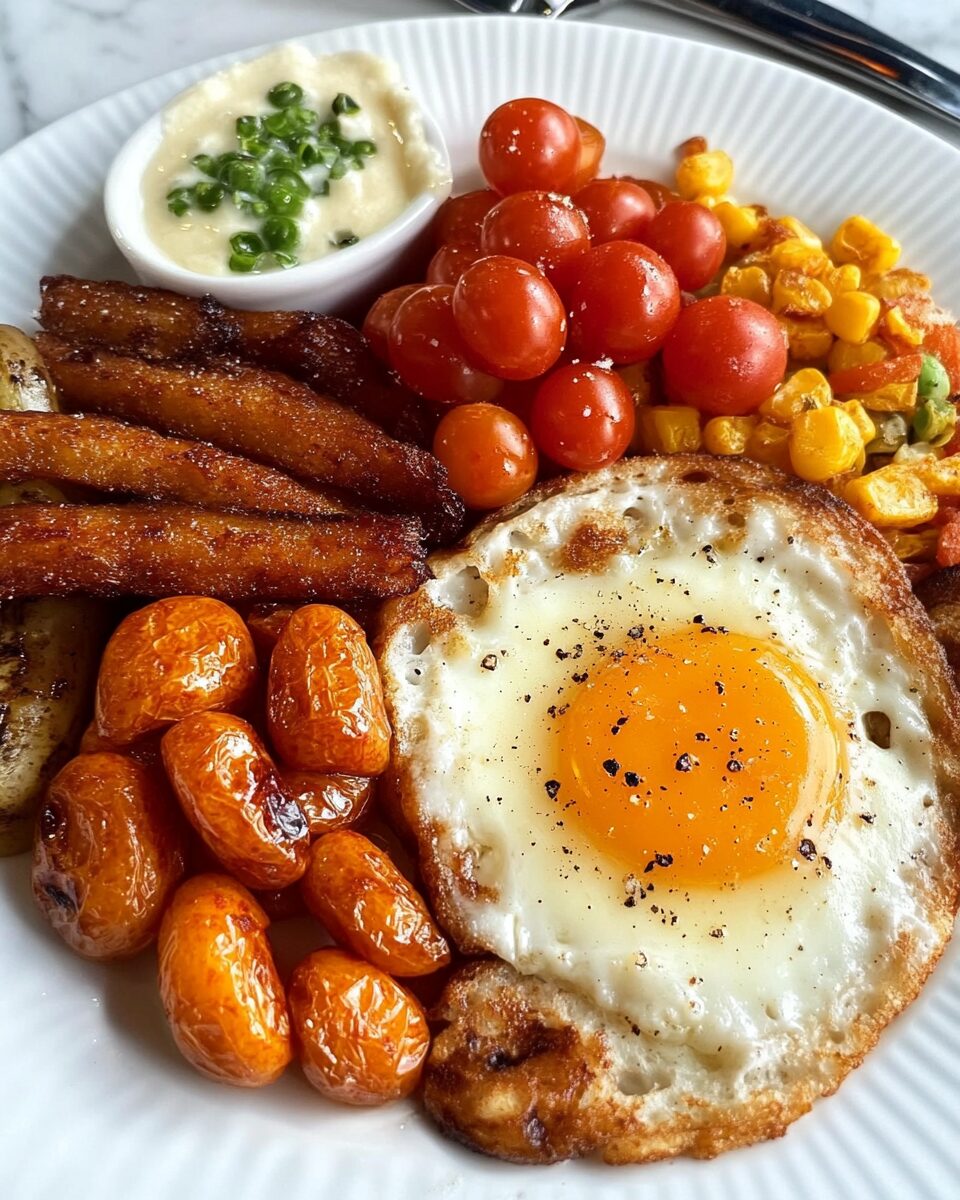Nothing says “good morning” quite like a Full English Breakfast. Packed with savory favorites sausages, eggs, beans, mushrooms, and more this iconic dish is a staple of British cuisine. It’s the kind of meal that fuels long days, lazy Sundays, and special brunches with loved ones. Whether you’re reminiscing about a trip to London or just craving something soul-satisfying, the Full English Breakfast delivers big on both flavor and comfort. It’s surprisingly simple to make and endlessly customizable depending on your tastes or what you have in the fridge. Every bite brings cozy warmth and bold flavor a perfect way to start the day.
Full Recipe:
Ingredients:
-
2 pork sausages
-
2 rashers of back bacon
-
1 egg
-
1 slice of black pudding
-
1 tomato, halved
-
1 cup baked beans
-
1 cup button mushrooms, sliced
-
2 slices of bread (for toast)
-
2 tablespoons butter
-
Salt and pepper, to taste
-
Oil for frying
Directions:
-
Heat a large frying pan over medium heat. Add a little oil. Fry the sausages for about 10-12 minutes, turning regularly until browned and cooked through.
-
Add the bacon to the pan and fry for about 3-4 minutes per side, until crisped to your liking.
-
In the same pan, add the black pudding and cook for 2-3 minutes on each side until crisp.
-
Place the halved tomato, cut side down, in the pan and cook for 2-3 minutes until slightly softened and seared.
-
Add the mushrooms to the pan with a small knob of butter and sauté for about 5 minutes until golden.
-
In a small saucepan, heat the baked beans over low heat until warmed through.
-
In a separate pan, fry the egg sunny side up with a little oil or butter, seasoning with salt and pepper.
-
Toast the bread slices and spread with butter.
-
Plate everything neatly: sausages, bacon, black pudding, egg, beans, tomato, mushrooms, and toast. Serve hot.
Prep Time: 10 minutes | Cooking Time: 25 minutes | Total Time: 35 minutes
Kcal: 750 kcal | Servings: 1 serving
The Ultimate Guide to the Full English Breakfast: A British Culinary Classic
Few meals hold such iconic status in a culture as the Full English Breakfast does in the UK. Known for its hearty portions, diverse flavors, and comforting appeal, this traditional morning feast is more than just a way to start the day it’s a culinary ritual that carries history, identity, and timeless appeal. In this article, we’ll explore the story behind the Full English, how it has evolved, the key components that make it unique, and how you can make it a star on your breakfast or brunch table.
The Origins of the Full English Breakfast
The Full English Breakfast, often simply referred to as a “fry-up,” has roots that stretch back to the early 13th century. During the Victorian era, it became a hallmark of the upper class, symbolizing hospitality and wealth. Aristocrats would serve elaborate breakfast spreads to guests before hunting expeditions or important meetings, and this tradition trickled down to the middle and working classes during the Industrial Revolution.
As workers needed a calorie-dense start to fuel long days in the fields or factories, the Full English became a daily staple for many British households. Today, while most Brits may not enjoy a Full English every morning, it remains a beloved weekend indulgence and a staple of cafes, pubs, and hotels across the UK.
What Makes It “Full”?
The term “Full English” isn’t just about size it’s about completeness. This breakfast isn’t just a couple of eggs and a piece of toast; it’s a full plate experience that engages multiple textures and flavors. The dish traditionally includes:
-
Sausages and Bacon – Meaty, savory, and often pan-fried until golden and crisp.
-
Eggs – Usually fried, though some opt for scrambled or poached.
-
Black Pudding – A type of blood sausage, earthy and rich.
-
Grilled Tomatoes and Mushrooms – A slightly acidic counterpoint to the heavier elements.
-
Baked Beans – Sweet and savory, these add comfort and a hint of nostalgia.
-
Toast or Fried Bread – To mop up everything else on the plate.
Some versions also include hash browns or bubble and squeak (a fried mix of leftover vegetables), and regional variations might swap or add items depending on local tastes.
The Cultural Significance of the English Fry-Up
The Full English Breakfast isn’t just food it’s part of Britain’s cultural fabric. From greasy spoon cafés in London to countryside B&Bs in Yorkshire, this meal is a symbol of national pride and resilience. It evokes the image of a warm kitchen, a bustling pub, or a leisurely weekend brunch. For many, it’s tied to childhood memories, hangover cures, or a reward after a long week.
This dish also stands out for its role in hospitality. Offering someone a Full English is a gesture of generosity. It’s also deeply nostalgic; it connects generations through a shared food memory that remains consistent even as other food trends come and go.
Full English vs. Other British Breakfasts
While the Full English is the most internationally recognized, the UK actually boasts several regional breakfast variations:
-
Full Scottish Breakfast – Adds haggis, tattie scones (potato scones), and often Lorne sausage (square sausage).
-
Full Irish Breakfast – Includes white pudding, soda bread, and sometimes boxty (Irish potato pancake).
-
Welsh Breakfast – May incorporate laverbread (seaweed purée) and cockles.
-
Ulster Fry – A Northern Irish variant, typically served with fried soda bread and potato bread.
Each variation is uniquely tied to its local ingredients and culinary traditions, but all share a love for hearty, comforting, and deeply satisfying breakfast fare.
Why the Full English Breakfast Endures
In an age of smoothie bowls, avocado toast, and intermittent fasting, it’s remarkable how the Full English Breakfast continues to thrive. Its appeal lies in its comfort factor and the sensory satisfaction it delivers. It’s not just one flavor profile it’s a full experience.
There’s also a growing movement toward reviving traditional foods with modern twists. Many restaurants now serve lighter, gourmet versions of the Full English, substituting in vegan sausages, grilled halloumi, or organic free-range eggs. Others play with presentation and plating, elevating the dish to fine-dining status while keeping its soul intact.
Even in health-conscious times, the occasional indulgence of a fry-up is celebrated. After all, food is about balance and few dishes hit that indulgent, nostalgic sweet spot like the Full English.
Modern Takes and Dietary Variations
While the traditional version remains popular, dietary preferences and modern lifestyles have led to innovative reinterpretations of the Full English Breakfast:
-
Vegetarian Versions – Swap the meat with veggie sausages, grilled halloumi, or avocado.
-
Vegan Fry-Up – Features plant-based sausages, tofu scramble, vegan black pudding, and dairy-free butter on toast.
-
Gluten-Free Fry-Up – Use gluten-free bread, sausages, and beans for an inclusive option.
-
Low-Fat or Low-Calorie Versions – Baking or grilling components instead of frying, using lean cuts of meat, or reducing portion sizes.
These adaptations have made the Full English more accessible and attractive to younger generations and global foodies alike.
How to Serve the Full English Breakfast
Presentation is key when serving a Full English. Each item should be cooked with care and given its place on the plate. Avoid overcrowding let each component shine. Use a large plate, and place the toast on the side to prevent sogginess. Garnish with fresh herbs like parsley or chives for a touch of color.
Pairing it with a hot beverage is traditional usually black tea with milk or strong coffee. For a more luxurious brunch, a mimosa or fresh juice can elevate the experience.
If serving at a gathering, consider creating a breakfast board or platter where guests can build their own plate. This interactive option is ideal for casual brunches and adds an element of fun to the meal.
Conclusion:
The Full English Breakfast is more than just a morning meal it’s an experience, a tradition, and a celebration of food’s ability to comfort, fuel, and connect. With its savory variety, rich history, and adaptability, it’s a dish that’s stood the test of time for good reason.
Whether you’re diving into a plate on a cold winter morning, hosting a weekend brunch, or simply curious about British cuisine, the Full English delivers satisfaction on every level. It’s a taste of the UK’s culinary roots served with modern flair and once you try it, it’s sure to earn a regular spot in your breakfast rotation.

